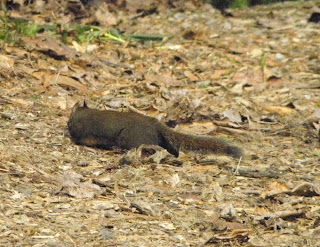 |
| Douglass Squirrel - Tamiasciurus douglasii photo credit - Chris Southwick |
Douglass Squirrels are one of the "Native" species of squirrels in WA State, but they are increasingly rare since their habitat has been overrun by the common Eastern Gray Squirrels shown in the photo.
They have also been sighted at Hamlin Park and in Boeing Creek Park areas.
 |
| ph credit - Chris Southwick |
WDFW has information on most of our native wildlife species. They recommend building nesting boxes to attract the Douglass Squirrel. Plans for constructing a nesting box can be found at the WDFW site at this link.
 |
| ph credit - WDFW |
Douglas' squirrel (Tamiasciurus douglasii)
Body: 7" Tail: 5"
Douglas' squirrels are small native tree squirrels. They are dark chestnut on the back fading to a reddish- or brownish-gray on the sides; their underparts are orange to gray and are offset by a short black stripe. The eye ring is pale orange. Their tails are somewhat bushy, slightly flattened and have a black tip. Douglas' squirrels vocalize often and have a range of calls from a low "chirr" to a sharp staccato "cough".
Chris Southwick serves on the board of the Puget Sound Bird Observatory and conducts permitted "bird banding" actions at her Briarcrest home. She lives near the Grace Cole Nature Park, which is located in Lake Forest Park, but is adjacent to Shoreline.






Thank you reminding us that most of the squirrels we see are not our native squirrels which are now living in isolated pockets. These squirrels are even more entertaining to observe than the now more common Eastern grays. This is one more example of why we need to work to repair the fragmentation of habitat mankind has imposed by creating wildlife corridors that reconnect our backyards with healthy plantings so our native animals can safely cross the landscape and repopulate.
ReplyDeleteThis is so cool!!
ReplyDeleteWonderful! Hooray for the Douglas squirrel!
ReplyDelete